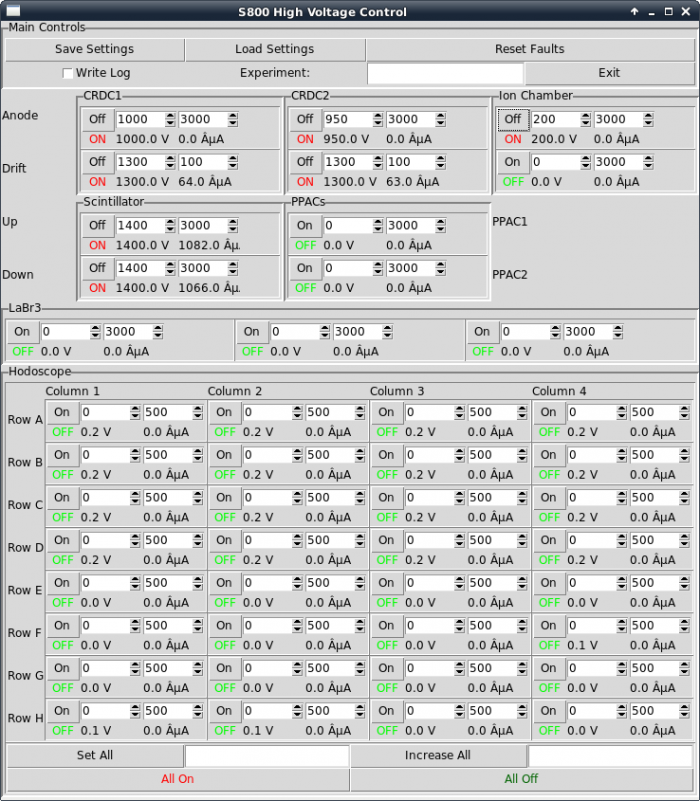This is an old revision of the document!
Table of Contents
Detector bias control
General Information
The TPPACs, the Ion Chamber, and the CRDCs have ISEG power supplies run through a single VME-based bias control. The computer interface for this bias control – the S800 Detector HV Control – is typically run on the devop1 computer in data-U6 and is started by clicking on S800 HV under the Operations option on the taskbar. The Object scintillator and the FP Scintillator are each controlled separately as described below under the sections for each detector.
Object Scintillator
The bias for the object scintillator is controlled via the H.V. power supply Canberra model 3002 D located in the crate to the right of the data-U6. The voltage will be adjusted at the beginning of the experiment. This scintillator has to be turned off or put on “standby” when entering the vault due to its sensitivity to light.
FP Scintillators
Only the fist two scintillators are typically used since in most cases particles do not reach beyond the second detector. The biases for the anode and the drift electrode are each controlled separately via the S800 Detector HV Control. To protect the scintillator PMT bases from damage from discharge under poor vacuum conditions (for example, during a window break on one of the nearby gas detectors), the 12-Volt supply for the PMT bases is interlocked to switch off if the pressure in the focal plane box rises above some minimum value as read by an ion gauge. The ion gauge controller (a black box with an LED digital display) is mounted on the south support structure for the focal plane chamber. The interlock condition is communicated to the PMT bias supply via a multi-pin “D” connector on the back of the controller. If the ion gauge is off, the interlock condition prevents biasing of the scintillator. It is possible to manually override the interlock condition for testing by connecting a “cheater” connector in place of the ion gauge controller to the cable for the interlock.
Ion Chamber
The biases for the anode and the drift electrode are each controlled separately via the S800 Detector HV Control. Parts of this detector rely on the same 12-Volt power supply used to power the bases of the FP Scintillator PMTs. If the vacuum-based interlock condition for protecting the FP Scintillator PMTs is triggered, the 12-Volt power supply will not be available for the Ion Chamber.
CRDCs
Each of the two detectors, CRDC1 and CRDC2, has a separate bias control for the anode and the drift electrode via the S800 Detector HV Control. Please keep in mind that a change in the drift voltage of the CRDCs strongly affects the drift velocity of the electrons and a new mask calibration has to be done to be able to determine the y position of particles. Apart from the CRDCs, it is important to bias the electrostatic gate (see section CRDC). The power supply is located in the crate to the right of the data-U6; the typical voltage is 26 V.
TPPACs
The bias of each of the two detectors, PPAC1 and PPAC2 is controlled individually via the S800 Detector HV Control. There are two types of detectors used for the TPPACs: either the “classic” PPACs or multi-strip PPACs with individual strip readouts for handling higher rates. There is not a difference between the two detector types in terms of how the data is used. They do differ in terms of electronics and acquisition.


